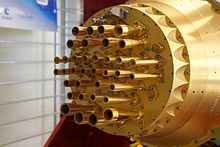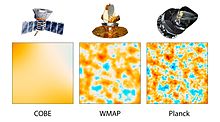Planck (spacecraft)
 A model of Planck | |||||||
| Names | COBRAS/SAMBA | ||||||
|---|---|---|---|---|---|---|---|
| Mission type | Space telescope | ||||||
| Operator | ESA | ||||||
| COSPAR ID | 2009-026B | ||||||
| SATCAT no. | 34938 | ||||||
| Website | www | ||||||
| Mission duration | Planned: >15 months Final: 4 years, 5 months, 8 days | ||||||
| Spacecraft properties | |||||||
| Manufacturer | Thales Alenia Space | ||||||
| Launch mass | 1,950 kg (4,300 lb)[1] | ||||||
| Payload mass | 205 kg (452 lb) | ||||||
| Dimensions | Body: 4.20 m × 4.22 m (13.8 ft × 13.8 ft) | ||||||
| Start of mission | |||||||
| Launch date | 14 May 2009, 13:12:02 UTC (2009-05-14UTC13:12:02) | ||||||
| Rocket | Ariane 5 ECA | ||||||
| Launch site | Guiana Space Centre, French Guiana | ||||||
| Contractor | Arianespace | ||||||
| Entered service | 3 July 2009 | ||||||
| End of mission | |||||||
| Disposal | Decommissioned | ||||||
| Deactivated | 23 October 2013, 12:10:27 UTC (2013-10-23UTC12:10:28) | ||||||
| Orbital parameters | |||||||
| Reference system | Sun-Earth L2 orbit (1,500,000 km / 930,000 mi) | ||||||
| Regime | Lissajous | ||||||
| Main telescope | |||||||
| Type | Gregorian | ||||||
| Diameter | 1.9 m × 1.5 m (6.2 ft × 4.9 ft) | ||||||
| Wavelengths | 300 μm – 11.1 mm (frequencies between 27 GHz and 1 THz) | ||||||
| |||||||
 ESA astrophysics insignia for Planck ← Herschel Gaia → | |||||||
Planck was a space observatory operated by the European Space Agency (ESA) from 2009 to 2013. It was an ambitious project that aimed to map the anisotropies of the cosmic microwave background (CMB) at microwave and infrared frequencies, with high sensitivity and angular resolution. The mission was highly successful and substantially improved upon observations made by the NASA Wilkinson Microwave Anisotropy Probe (WMAP).
The Planck observatory was a major source of information relevant to several cosmological and astrophysical issues. One of its key objectives was to test theories of the early Universe and the origin of cosmic structure. The mission provided significant insights into the composition and evolution of the Universe, shedding light on the fundamental physics that governs the cosmos.
Planck was initially called COBRAS/SAMBA, which stands for the Cosmic Background Radiation Anisotropy Satellite/Satellite for Measurement of Background Anisotropies. The project started in 1996, and it was later renamed in honor of the German physicist Max Planck (1858–1947), who is widely regarded as the originator of quantum theory by deriving the formula for black-body radiation.
Built at the Cannes Mandelieu Space Center by Thales Alenia Space, Planck was created as a medium-sized mission for ESA's Horizon 2000 long-term scientific program. The observatory was launched in May 2009 and reached the Earth/Sun L2 point by July 2009. By February 2010, it had successfully started a second all-sky survey.
On 21 March 2013, the Planck team released its first all-sky map of the cosmic microwave background. The map was of exceptional quality and allowed researchers to measure temperature variations in the CMB with unprecedented accuracy. In February 2015, an expanded release was published, which included polarization data. The final papers by the Planck team were released in July 2018, marking the end of the mission.
At the end of its mission, Planck was put into a heliocentric graveyard orbit and passivated to prevent it from endangering any future missions. The final deactivation command was sent to Planck in October 2013.
The mission was a remarkable success and provided the most precise measurements of several key cosmological parameters. Planck's observations helped determine the age of the universe, the average density of ordinary matter and dark matter in the Universe, and other important characteristics of the cosmos.
Objectives
The mission had a wide variety of scientific aims, including:[2]
- high resolution detections of both the total intensity and polarization of primordial CMB anisotropies,
- creation of a catalogue of galaxy clusters through the Sunyaev–Zel'dovich effect,
- observations of the gravitational lensing of the CMB, as well as the integrated Sachs–Wolfe effect,
- observations of bright extragalactic radio (active galactic nuclei) and infrared (dusty galaxy) sources,
- observations of the Milky Way, including the interstellar medium, distributed synchrotron emission and measurements of the Galactic magnetic field, and
- studies of the Solar System, including planets, asteroids, comets and the zodiacal light.
Planck had a higher resolution and sensitivity than WMAP, allowing it to probe the power spectrum of the CMB to much smaller scales (×3). It also observed in nine frequency bands rather than WMAP's five, with the goal of improving the astrophysical foreground models.
It is expected that most Planck measurements have been limited by how well foregrounds can be subtracted, rather than by the detector performance or length of the mission, a particularly important factor for the polarization measurements.[needs update] The dominant foreground radiation depends on frequency, but could include synchrotron radiation from the Milky Way at low frequencies, and dust at high frequencies.[needs update]
Instruments



The spacecraft carries two instruments: the Low Frequency Instrument (LFI) and the High Frequency Instrument (HFI).[2] Both instruments can detect both the total intensity and polarization of photons, and together cover a frequency range of nearly 830 GHz (from 30 to 857 GHz). The cosmic microwave background spectrum peaks at a frequency of 160.2 GHz.
Planck's passive and active cooling systems allow its instruments to maintain a temperature of −273.05 °C (−459.49 °F), or 0.1 °C above absolute zero.[3] From August 2009, Planck was the coldest known object in space, until its active coolant supply was exhausted in January 2012.[4]
NASA played a role in the development of this mission and contributes to the analysis of scientific data. Its Jet Propulsion Laboratory built components of the science instruments, including bolometers for the high-frequency instrument, a 20-kelvin cryocooler for both the low- and high-frequency instruments, and amplifier technology for the low-frequency instrument.[5]
Low Frequency Instrument
| Frequency (GHz) | Bandwidth (Δν/ν) | Resolution (arcmin) | Sensitivity (total intensity) ΔT/T, 14-month observation (10−6) | Sensitivity (polarization) ΔT/T, 14-month observation (10−6) |
|---|---|---|---|---|
| 30 | 0.2 | 33 | 2.0 | 2.8 |
| 44 | 0.2 | 24 | 2.7 | 3.9 |
| 70 | 0.2 | 14 | 4.7 | 6.7 |
The LFI has three frequency bands, covering the range of 30–70 GHz, covering the microwave to infrared regions of the electromagnetic spectrum. The detectors use high-electron-mobility transistors.[2]
High Frequency Instrument

| Frequency (GHz) | Bandwidth (Δν/ν) | Resolution (arcmin) | Sensitivity (total intensity) ΔT/T, 14-month observation (10−6) | Sensitivity (polarization) ΔT/T, 14-month observation (10−6) |
|---|---|---|---|---|
| 100 | 0.33 | 10 | 2.5 | 4.0 |
| 143 | 0.33 | 7.1 | 2.2 | 4.2 |
| 217 | 0.33 | 5.5 | 4.8 | 9.8 |
| 353 | 0.33 | 5.0 | 14.7 | 29.8 |
| 545 | 0.33 | 5.0 | 147 | N/A |
| 857 | 0.33 | 5.0 | 6700 | N/A |
The HFI was sensitive between 100 and 857 GHz, using 52 bolometric detectors, manufactured by JPL/Caltech,[6] optically coupled to the telescope through cold optics, manufactured by Cardiff University's School of Physics and Astronomy,[7] consisting of a triple horn configuration and optical filters, a similar concept to that used in the Archeops balloon-borne experiment. These detection assemblies are divided into 6 frequency bands (centred at 100, 143, 217, 353, 545 and 857 GHz), each with a bandwidth of 33%. Of these six bands, only the lower four have the capability to measure the polarisation of incoming radiation; the two higher bands do not.[2]
On 13 January 2012, it was reported that the on-board supply of helium-3 used in Planck's dilution refrigerator had been exhausted, and that the HFI would become unusable within a few days.[8] By this date, Planck had completed five full scans of the CMB, exceeding its target of two. The LFI (cooled by helium-4) was expected to remain operational for another six to nine months.[8]
Service module

A common service module (SVM) was designed and built by Thales Alenia Space in its Turin plant, for both the Herschel Space Observatory and Planck missions, combined into one single program.[2]
The overall cost is estimated to be €700 million for the Planck[9] and €1,100 million for the Herschel mission.[10] Both figures include their mission's spacecraft and payload, (shared) launch and mission expenses, and science operations.
Structurally, the Herschel and Planck SVMs are very similar. Both SVMs are octagonal in shape and each panel is dedicated to accommodate a designated set of warm units, while taking into account the dissipation requirements of the different warm units, of the instruments, as well as the spacecraft. On both spacecraft, a common design was used for the avionics, attitude control and measurement (ACMS), command and data management (CDMS), power, and tracking, telemetry and command (TT&C) subsystems. All units on the SVM are redundant.
Power Subsystem
On each spacecraft, the power subsystem consists of a solar array, employing triple-junction solar cells, a battery and the power control unit (PCU). The PCU is designed to interface with the 30 sections of each solar array, to provide a regulated 28 volt bus, to distribute this power via protected outputs, and to handle the battery charging and discharging.
For Planck, the circular solar array is fixed on the bottom of the satellite, always facing the Sun as the satellite rotates on its vertical axis.
Attitude and Orbit Control
This function is performed by the attitude control computer (ACC), which is the platform for the attitude control and measurement subsystem (ACMS). It was designed to fulfil the pointing and slewing requirements of the Herschel and Planck payloads.
The Planck satellite rotates at one revolution per minute, with an aim of an absolute pointing error less than 37 arc-minutes. As Planck is also a survey platform, there is the additional requirement for pointing reproducibility error less than 2.5 arc-minutes over 20 days.
The main line-of-sight sensor in both Herschel and Planck is the star tracker.



































